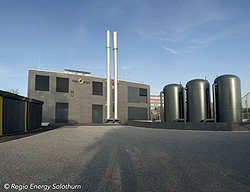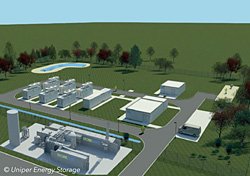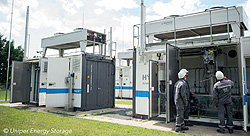 In order for the European Union (EU) to meet the assigned target of reducing CO2 emissions by at least 40 per cent by 2030 compared to 1990 and by 80–95 percent by the year 2050, the majority of fossil and nuclear energy must be replaced with renewable energy. As renewable sources tend to be volatile and generate energy intermittently, long-term storage is required.
In order for the European Union (EU) to meet the assigned target of reducing CO2 emissions by at least 40 per cent by 2030 compared to 1990 and by 80–95 percent by the year 2050, the majority of fossil and nuclear energy must be replaced with renewable energy. As renewable sources tend to be volatile and generate energy intermittently, long-term storage is required.
An EU Horizon 2020 Research and Innovation programme project coordinated by the DVGW Research Center at Engler-Bunte-Institute, Germany, is striving to integrate power-to-gas (PtG) technology into Europe’s future energy system. The project, 'Innovative Large Scale Energy STORagE Technologies & Power-to-Gas Concepts after Optimisation’ (STORE&GO), involves the demonstration of three different PtG concepts in: Falkenhagen, Germany; Solothurn, Switzerland; and Troia, Italy. The work builds on previous research that has demonstrated the technical feasibility of PtG technologies, and seeks to further enhance the technology's ability in order that it can be integrated into the daily operation of European energy grids.
The project is led by Dr Frank Graf and involves the participation of 27 partner organisations and companies from across Europe, specifically Austria, France, Germany, Italy, the Netherlands and Switzerland. Project activities are spread over nine work packages. To ensure smooth coordination and collaboration between the project partners, the STORE&GO consortium utilises an online project management platform, which enables the researchers to continuously exchange their progress and findings with each other.
 The team feels this level of collaboration is required due to the extent of the expertise required for such an undertaking. 'We are convinced that it is not sufficient to simply serve the public a powerful new technology,' Graf highlights. 'Instead, we need to analyse the strengths of PtG so that we can give precise recommendations regarding how and where to roll out this technology. Policy makers and investors need to be told how, when and where they can apply this technology to generate a business case, or to safeguard the security of supply, or to protect the environment.' For this reason, the STORE&GO consortium benefits from the involvement of large industrial players, innovative small companies, and research institutes with a focus on reactor concepts, electricity grids, techno-economical studies, business development and law. These partners provide the experience and knowledge necessary to ensure that STORE&GO's activities result in real-world change.
The team feels this level of collaboration is required due to the extent of the expertise required for such an undertaking. 'We are convinced that it is not sufficient to simply serve the public a powerful new technology,' Graf highlights. 'Instead, we need to analyse the strengths of PtG so that we can give precise recommendations regarding how and where to roll out this technology. Policy makers and investors need to be told how, when and where they can apply this technology to generate a business case, or to safeguard the security of supply, or to protect the environment.' For this reason, the STORE&GO consortium benefits from the involvement of large industrial players, innovative small companies, and research institutes with a focus on reactor concepts, electricity grids, techno-economical studies, business development and law. These partners provide the experience and knowledge necessary to ensure that STORE&GO's activities result in real-world change.
The researchers are working to reduce the energy losses and costs associated with existing methods of converting energy. In addition, the team has identified that there is currently no place for PtG in the legislative framework. At present, regulations exist for either electricity or for gas, but not both, meaning that interfaces between the two networks are not accounted for. This state of affairs presents a range of problems, as it creates uncertainty regarding who may operate a PtG plant (i.e. a system operator or a gas producer), there are no clear approval procedures, and plants run the risk of being liable for double fees. This is something that the STORE&GO consortium wishes to change. 'We dearly hope that PtG will be considered in the ongoing revision of the EU’s energy legislation,' Graf explains.
Each of the three concepts being demonstrated in STORE&GO involves novel methanation technologies, and each has been adapted for the respective demonstration site. These PtG plants will be integrated into the power, heat and gas grids for further transport and integration. The idea is that this will enable the researchers to feed renewable methane into the existing natural gas grid in a climate-neutral way without any restrictions, which means it can be made available for a wide range of customer applications. ‘The demo sites provide highly diverse testbeds: different climates; grid types and topologies, like transmission or distribution; different combination of solar, wind and hydro energy; and different CO2 sources, including bioethanol, waste water and directly from air,' Graf elaborates. 'This way, we can analyse and compare the advantages of PtG in various environments.'
 Two of the sites use thermo-catalytic methanation, with reactors designed specifically to improve the heat management of the exothermic methanation reaction that is needed to ensure high conversion rates of hydrogen and CO2 to methane. In addition, the researchers expect that these reactors will have constructive advantages that will result in cost reductions. At the third site, a biological methanation reactor is used. This involves microorganisms called Archaea breathing in hydrogen and exhaling methane. 'This concept seems to be feasible, especially in context with biogas plants in rural areas,' underlines Graf.
Two of the sites use thermo-catalytic methanation, with reactors designed specifically to improve the heat management of the exothermic methanation reaction that is needed to ensure high conversion rates of hydrogen and CO2 to methane. In addition, the researchers expect that these reactors will have constructive advantages that will result in cost reductions. At the third site, a biological methanation reactor is used. This involves microorganisms called Archaea breathing in hydrogen and exhaling methane. 'This concept seems to be feasible, especially in context with biogas plants in rural areas,' underlines Graf.
In addition, the team is analysing the existing regulatory and legislative framework, in order to identify where PtG fits in. As such, the researchers are involved in the BRIDGE initiative – a cooperation group involving to date 32 low carbon energy (LCE) smart-grid and energy storage projects funded under Horizon 2020. The researchers are also conducting a multi-country survey in order to identify acceptance or resistance in relation to PtG.
The team hopes to accelerate market uptake by identifying business models; creating a European PtG map displaying the most promising locations to install facilities; and developing a European PtG roadmap that contains recommendations regarding which applications PtG may serve in the short-, mid- and long-term. 'This European PtG roadmap will be a central outcome of the project,' reveals Graf. The team hopes that the STORE&GO project will benefit end users across Europe by ensuring a sustainable supply of energy and therefore guaranteeing security. 'Furthermore, the gas generated by PtG can replace fossil gas in any application, like heating and transport,' states Graf. 'It thus helps to free the heating and transport sector from fossil CO2 emissions.’ The team is pleased with the progress STORE&GO has made to date and is confident it is on target to achieve project objectives and, ultimately, enhance the future of energy storage and provision, benefitting humankind.
Contact Details:
Frank Graf
DVGW Research Center at the Engler-Bunte Institute, Karlsruhe Institute of Technology (KIT)
Engler-Bunte-Ring 3
76131 Karlsruhe, Germany
web: www.dvgw-ebi.de